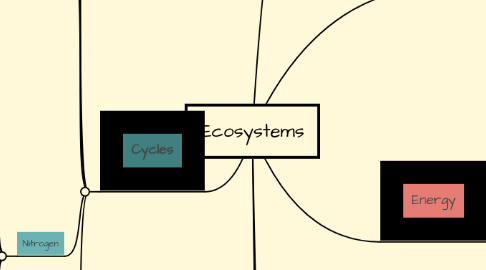
1. Cycles
1.1. Biogeochemical
1.1.1. Movement of bioelements
1.1.1.1. From natural reservoirs to food chainds
1.1.1.2. Back to the envioronment
1.2. Water
1.2.1. Where?
1.2.1.1. Ocean
1.2.1.2. Atmosphere
1.2.1.3. Land
1.2.2. How?
1.2.2.1. Vapor
1.2.2.2. Condensate
1.2.3. Uses
1.2.3.1. Filtrates
1.2.3.2. Transport Nutrients
1.2.4. Problems
1.2.4.1. Limited
1.2.4.2. Overdraft
1.2.4.3. Bad Use
1.3. Carbon
1.3.1. Atmospheric cycles
1.3.1.1. Terrestial Carbon Cycle
1.3.1.1.1. Plants incorporate C02
1.3.1.2. Marine Carbon Cycle
1.3.1.2.1. C02 Dissolved on the water
1.3.1.3. Carbon in Fossil Fuels
1.3.1.3.1. Organic Remains Stored
1.4. Nitrogen
1.4.1. Composes DNA&RNA
1.4.2. Nitrogen Fixations
1.4.2.1. Ammonium
1.4.2.2. Plants
1.4.2.3. Consumers
1.4.2.4. Bacteria
1.4.2.5. Soil
1.4.3. Nitrification
1.4.3.1. Ammonium
1.4.3.2. Bacteria
1.4.3.3. Nitrite
1.4.3.4. Bacteria
1.4.3.5. Nitrates
1.4.3.6. Producers
1.4.4. Loss/Denitrification
1.4.5. Disruption
1.4.5.1. New techniques
1.4.5.2. Increase of Fossile Fuels, Fertilizers
1.4.5.3. Pollution
1.4.5.3.1. Water
1.4.5.3.2. Diseases
1.4.5.3.3. Destroys Ozone
1.5. Phosphorous
1.5.1. Passes Through Food Webs Quickly
1.5.2. Sedimentary Cycle
1.5.2.1. Rocks
1.5.2.2. Weathering/Erosion
1.5.2.3. Water
1.5.2.4. Deposits
1.5.2.5. Land
1.5.3. Way
1.5.3.1. Soil Water
1.5.3.2. Plants
1.5.3.3. Animals
1.5.3.4. Waste
2. Nutrients
2.1. Mostly Cyclic
2.2. Process
2.2.1. Environment
2.2.2. Producers
2.2.3. Consumers
2.3. H,O,C,N,P
3. Food web
3.1. Food Chain
3.1.1. Trophic levels
3.1.2. Producers and Consumers
3.2. Types
3.2.1. Grazing
3.2.1.1. Primary Consumer eats Primary Producers
3.2.2. Detrital
3.2.2.1. Detritivores get enegry from producers
4. Energy
4.1. Primary Producers
4.1.1. Inorganic to Organic
4.2. Consumers
4.2.1. Hervibores/Carnivores/ Parasites/Omnivores
4.3. Not a Cycle
4.4. Ecological Pyramids
4.4.1. Biomass
4.4.1.1. By weight of each trophic level
4.4.2. Energy
4.4.2.1. By loss of energy through thropic levels
4.5. Ecological Efficiency
4.5.1. Use of Energy
4.5.2. Losses
4.5.2.1. Heat
4.5.2.2. Can not digest
5. Greenhouse Gases and Climate Change
5.1. Increase of Greenhouse Gases
5.2. Problems
5.2.1. Raise of Temperature
5.2.2. Diseases
5.2.3. Loss of Ice
5.2.4. Need of New Solutions
